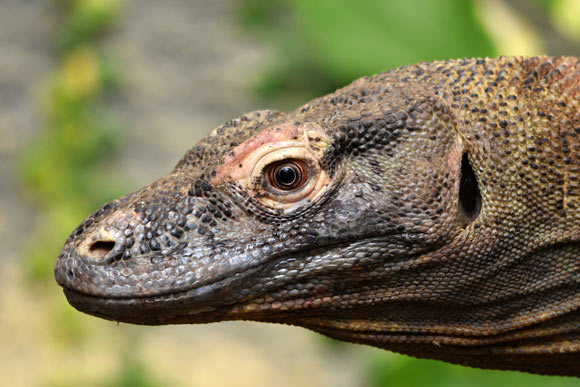An international team of scientists has mapped and analyzed the entire genome of the Komodo dragon (Varanus komodoensis), the largest extant monitor lizard.
Komodo dragons can grow to 10 feet (3 m) in length and run up to 12 mph (20 kmh), allowing them to hunt large prey including deer and boar.
Although they are cold-blooded, Komodo dragons can ramp up their metabolism to near mammalian levels, which gives them great speed and endurance.
Their ability to locate injured or dead prey through scent tracking over several miles is enabled by a powerful olfactory system, and their hunting is aided by serrate teeth, sharp claws, and saliva with anticoagulant and shock-inducing properties.
Furthermore, they engage in aggressive intraspecific conflicts over mating, territory and food, and wild individuals often bear scars from previous conflicts.
The team, led by Gladstone Institutes and University of California, San Francisco researchers Benoit Bruneau and Katherine Pollard, studied the DNA of two Komodo dragons from Zoo Atlanta named Slasher and Rinca, whose blood samples were obtained as part of their scheduled annual check-ups.
“We used multiple technologies, including long-range sequencing and a physical mapping technique to do the assembly,” Professor Bruneau said.
“As a result, we have a super deep, very high-quality sequence for the Komodo.”
Once the scientists had the sequence, they used computational tools to compare it to that of other reptiles and see what makes the Komodo dragon genome unique.
Specifically, they were looking for changes in the genome that helped the Komodo dragon adapt to its environment, which have undergone an evolutionary process called positive selection.
A remarkable finding was that positive selection has shaped several genes involved in the function of mitochondria, the energy powerhouses of the cell that control how well heart and other muscles function.
“Our analysis showed that in Komodo dragons, many of the genes involved in how cells make and use energy had changed rapidly in ways that increase the lizard’s aerobic capacity. These changes are likely key to the Komodo’s ability to achieve near-mammalian metabolism,” said study first author Dr. Abigail Lind, a postdoctoral researcher at Gladstone Institutes.
In addition, the team discovered that Komodo dragons, along with some other lizards, have an unexpectedly large number of genes that encode chemical sensors known as vomeronasal receptors.
These receptors are part of a sophisticated sensory system that allows animals to detect hormones and pheromones.
This type of sensing is involved in a variety of activities, including kin recognition, mate choice, predator avoidance, and hunting.
In the Komodo genome, the scientists found over 150 copies of one class of vomeronasal receptor genes.
They also found that many of these genes are unique to each individual lizard species, raising the possibility that the Komodo dragon’s vomeronasal receptors may function in Komodo-specific ways.
“It will be interesting to determine whether this explains Komodo dragons’ ability to detect prey over such large distances,” Professor Bruneau said.
“I went to Komodo Island years ago as a tourist, and I saw Komodo dragons in the wild there,” Dr. Pollard said.
“I never would have guessed then that I would one day work on their genome. We didn’t even have a human genome at that time.”
The results were published in the journal Nature Ecology & Evolution.
_____
Abigail L. Lind et al. 2019. Genome of the Komodo dragon reveals adaptations in the cardiovascular and chemosensory systems of monitor lizards. Nature Ecology & Evolution 3: 1241-1252; doi: 10.1038/s41559-019-0945-8








